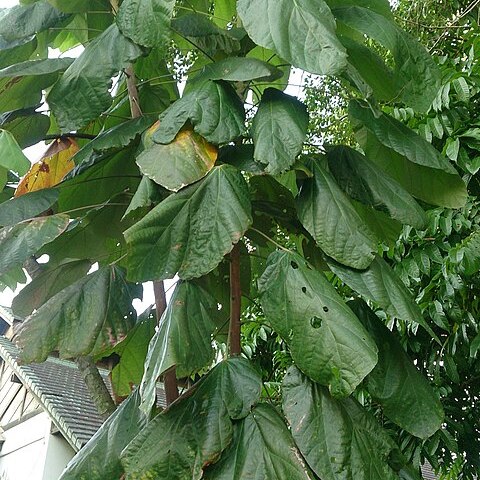Tree usually 3-8 m. tall, up to 25-30 m. in high forest, with rather narrow crown; growth below jorquette; trunk erect with light bark and white wood; pri-mary branches ternate, dichotomous, spreading, horizontal or pendulous, subterete, densely and appressed-cinereous-tomentose with minute, stellate hairs; older branches glabrate, smooth, gray; stipules oblong-lanceolate, minutely appressed-tomentose, more or less persistent. Leaves with a petiole rather thick, subterete, 12-25 mm. long, minutely appressed-tomentose; blade oblong-ovate or elliptic-ovate, cordate or emarginate, asymmetrical at base, attenuate, abruptly acuminate at apex, entire or rarely sinuate at the upper margin, 12-34 cm. long and 6-18 cm. broad, the acumen triangular and 6-12 mm. long, firmly chartaceous, subpalmatinerved; upper surface green, glabrous or with scattered hairs, the main nerves noticeable, the lesser slightly conspicuous; lower surface silvery-greenish or cinereous, covered with a dense layer of intricate, stellate hairs, 5-to 7-nerved at base, the thicker costa and 2 or 3 main nerves on each side strongly prominent; leaves on primary stem and chupons larger, symmetrical, deeply cordate, 30-50 cm. long and 21-36 cm. broad, with a petiole 10-38 cm. long. Inflorescences axillary or extra-axillary on leafy, juvenile branchlets, usually 3-6 cm. broad, with short axis and divaricate, dichasial and cincinnate branching, densely ochraceous-or cinereous-tomentose; pedicels 3-6 mm. long; bracteoles 1.5-2.5 mm. long, densely and minutely tomen-tose; buds oblong-ovate, subacute, minutely cinereous-or ochraceous-tomentose. Flowers with spreading, lanceolate or ovate-lanceolate sepals, these shortly connate at base, acute at apex, 5-6 mm. long and 2-2.5 mm. broad, subappressed-stellate-tomentose and reddish outside, 3-nerved and sparsely pilose inside; petal-hoods oblong-obovate, rounded-cucullate with incurved apex, 2-2.5 mm. long and 1-1.2 mm. broad, submembranaceous, whitish-rosy or reddish with a darker midrib, hir-tellous-pubescent with a depressed, tomentellous midrib outside, glabrous with a thick, trifurcate midrib inside; petal-laminae ovate, abruptly contracted at base in a short nail, rounded at apex, 1-1.2 mm. long and 0.8 mm. broad, carnose, red, brownish-red or purplish, hirtellous-pubescent; staminodes linear-oblong, slightly narrowed at base, obtuse or subacute at apex, 3.5-4.5 mm. long and 0.6-0.8 mm. wide, carnose, brownish-red, covered with minute, thickish, patulous hairs; filaments about 1-1.5 mm. long, glabrous, 2-antheriferous; ovary velutinous-tomentose; styles united, rigid, whitish. Fruit subglobose-ellipsoid or oblong-ellipsoid, 15-20 (10-25) cm. long and 9-12(-15) cm. broad, green, when ripe yellow or brownish; pericarp hard, woody, 7-15 mm. thick, densely stellate-pilose, strongly 10-costate, the deep furrows reticulate, deeply lacunose; pulp fibrose, yellowish, sweet, scented; seeds complanate, ovoid-amygdaliform, 16-30 mm. long, 14-23 mm. wide and 8-13 mm. thick; embryo white; germination epigeous.
More
A small evergreen tree. It grows 10-13 m high. It can be 30 m high in the forest. The leaves are papery and 15-35 cm long. They can have 2 colours. The flowers are in small groups on the thin branches. The fruit can weigh 300 g. The fruit is medium to large. It is 8-12 cm across. The fruit is cone shaped. The inside of the fruit is chocolate coloured.


